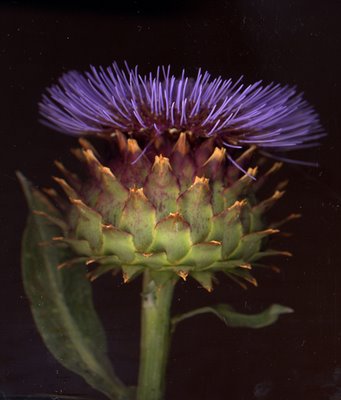
In my garden my Rosemary grows several Cyanara cardunculus. These stately (8 to 9 ft tall) thistle-like plants have flowers (above, and cut from today's garden) that resemble thistles and leaves that resemble the leaves of the Acanthus, the plant that the Greeks used as models for their Corinthian column capitals. But Cynara cardunculus is not a thistle it is a close relative of the artichoke or Cynara scolymus.
In his Voyage of the Beagle Charles Darwin describes the Argentine pampas around 1833.
"But the cardoon (Cynara cardunculus) has a far wider range. It occurs in these latitudes on both sides of the Cordillera, across the continent. I saw it unfrequented spots in Chile, Entre Rios[an area North East of Buenos Aires]and the Banda Oriental [modern day Uruguay]. In the latter country alone, very many (probably several hundred) square miles are covered by one mass of these prickly plants and are impenetrable by man or beast. Over the undulating plains, where these great beds ocurr, nothing else can now live."
It seems that in Darwin's time there were areas not yet populated by the cardoon which was a plant brought to America by the European colonizers. This is an example of a non native and aggressive plant that destroyed and replaced some of the original herbage of the Argentine pampa. But in my journey through the pampas in the 50s, 60s I don't recall seeing the cardunculus in mass. All I saw was the cardo (as Argentines call) the really prickly thistle of the pampas. I decided to look it all up and I found out that Europeans in the 1920s brought the Scotch thistle or Onopordum acanthium with them. This real thistle, much more aggressive than the cardoon, has systematically taken over. I had a Scotch thistle in our garden a couple of years ago. I found it beautiful. But I would agree with Rosemary that Darwin's (as I call it now) cardoon is far more beautiful. When I gaze on it I can imagine Darwin galloping with his friend, Argentine strongman Juan Manuel de Rosas in search of fast Argentine ostriches.